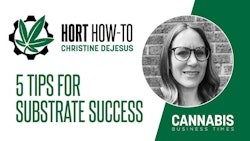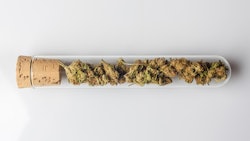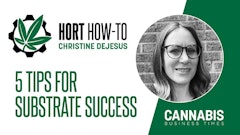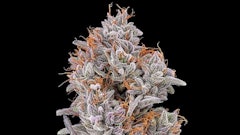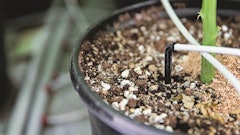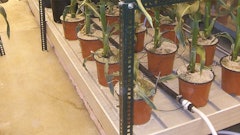
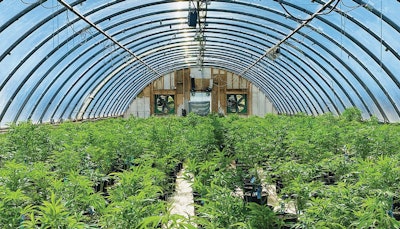
There are many container options on the market, and new ones come out every year boasting benefits. Weighing your options and putting proper thought into container selection, which is one of the most overlooked aspects of cultivation, can play into your crop’s success. Here are four considerations when determining what type of container is best for your grow.
1. Set a budget and weigh convenience and durability.
Container selection starts by determining your budget and how much you are willing to spend on containers. There are myriad options, including fabric pots, blow-molded pots, injection-molded pots, plastic bag pots, mesh pots, plastic disposable cups and more.
If your budget is small, opting for less-expensive plastic cups for small plants and plastic bag pots for later stages may be the most feasible option at startup. Whether you select plastic cups or plastic bags, hundreds of each can cost less than $100, making them affordable choices for limited-budget operations.
Other options include hard plastic blow-molded and injection-molded pots, which tend to be more durable and easier to clean between harvests. Both last multiple years and are easy to clean, fill, empty and move while protecting roots because of their hard sides. While they stack and store well, they can take up lots of space, depending on the size of your pot and facility.
Mesh and fabric pots have become popular choices because they dry quickly, provide optimal aeration and drain well. With mesh and fabric pots, cleaning and storage are easy and convenient, with the ability to stack and squeeze many of them. They are more expensive; a 5-gallon pot is about $7, depending on your source and order size.
Remember: Spending a little more can make a huge difference on the quality and quantity of the product you produce, but at the end of the day, your budget is your budget, so make the most out of what you can afford.
2. Select proper container sizes based on plant height and facility layout.
Each type of container has multiple size options. However, there are a few considerations that can dictate container size and how many different pot sizes you will have.
First, think about how large you want plants to grow. Is your space set up for a sea of smaller, shorter plants grouped together? Or, do you plan to grow plants that each fill up a 16-square-foot area? Usually when picking a pot size, growers start with 5 gallons of soil for every 3 feet of height on your average-size cultivar (3 to 5 feet). So, for example, 5 gallons of soil for a 3-foot plant is a solid start, and for a 6-foot plant, a 10-gallon pot is a good choice.
There are tall or squat options in most pots as well as many options in between multiples of 5 gallons. A slightly smaller or bigger pot may work best depending on your grow environment and how your plants absorb water.
Then, consider how to best space containers for efficiency and effectiveness, whether through a sea-of-green technique, in which many plants simultaneously grow to modest sizes, or by cultivating a smaller number of robust plants for higher per-plant yields.
If you have the availability, time and space, trial container sizes to see which option is best for cost, efficiency, yield and plant health for your grow.
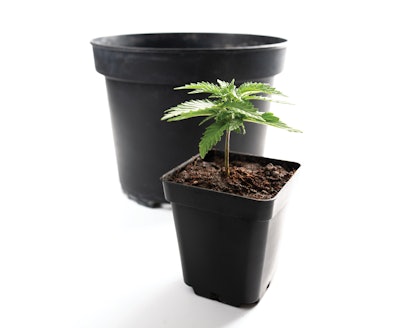
3. Develop a container transfer plan based on number of weeks to flower.
You likely have some idea of how quickly plants grow in your facility based on your controls and prior experience. Determining how many weeks you will need to root clones and veg your plants to their ideal size before flower, as well as how tall they will be upon harvest, is crucial to determining container size through the plant lifecycle. As plants grow, containers need to be transitioned gradually so they properly establish roots.
There are many different variables when it comes to transplanting between growth stages, such as pot type, growing media and growing environment.
For outdoor cultivators, to save on labor and time, consider using a small pot that is 2 gallons or less and then transition into your finish pot as soon as the plants are ready to be transplanted. Depending on your location, plants may spend multiple months in the finish pot, as grow seasons can extend into November, and a plant will grow exponentially with proper sunlight and water, through both veg and flower. This can produce rather large plants, which in most cases requires growing plants in at least 20 gallons of soil.
Cannabis grown in greenhouses usually requires a gallon or less beginner pot, and then depending on grow style and time available, you may be able to transplant directly to your finish pot if it is 20 gallons or less. (Greenhouse plants usually take around a week for every 5 gallons after the initial pot to achieve optimal vegetative growth.) If your finish pot is 20 gallons or more, moving plants to a roughly 5-gallon pot before transplanting it to the finish pot will encourage the plant to develop a larger root base, allowing plants to establish roots in the larger pot. Adding the additional step of a 5-gallon transition pot adds labor and a whole inventory of another size pot, however, so in some operations, it might make sense to avoid this time and cost.
The recommendations for indoor operations are similar, but generally growers opt for a slightly smaller, half-gallon size. However, plants can grow quickly in certain indoor environments and nearly double in size in the first two weeks of flower. Usually two pots will be enough unless the grow has very large plants.
4. Space pots for production and efficiency.
One of the fun and challenging aspects about growing cannabis is all the ways it can be done efficiently and effectively. At the same time, it’s important to know that each market develops its own strategies.
State regulations dictating plant count or canopy space can greatly affect a grow’s layout and spacing. However, even if you don’t have a plant or canopy space limit, techniques such as perpetual harvesting can improve your operation’s efficiency and effectiveness.
Working in a plant-count state like Colorado means you have an exact number of plants you can grow depending on your tier. Tier one in recreational licensing is 1,800 plants. Our grow splits its 1,800 plants between our greenhouse and outdoor spaces. We try to plant 600 plants outdoors because they fill out our 1-acre plot well with how we have set up irrigation and netting, so we grow the other 1,000 in the greenhouse perpetually, meaning, similar to indoor cultivators, we are always filling up our flowering space with plants as soon as they are empty with a separate space to veg, so there is always a flowering crop.
Outdoors, growth cycles and season length both need to be taken into consideration. Plan for plants to grow at least 2 feet tall and 1 foot wide a month once they are established in the veg stage. Depending on expected first and last freezes of the year, you can get a pretty good idea of how big your plant will be.
Try to space your pots to have room for extra growth. If you think your plants will be 6 feet wide, give yourself 7 feet from the center of one pot to the center of the next. Also, giving yourself space to walk outside can help keep weeds manageable, as you can better work around the plant.
A greenhouse environment normally requires at least two to two-and-a-half full crops simultaneously spread out between the three growth stages in the facility. Growers can experiment with how exactly to spread out the plants in their various growth stages. For instance, with the 1,200 plants we keep in our greenhouse at one time, we put a crop of 100 plants into flower every two weeks to fill out about 1,800 square feet of grow space, keeping four crops there at one time or 400 plants total. Since we flower for around eight weeks, this gives the plants 16 weeks in veg to fill out before filling the flower space.
By only vegging plants for a few weeks and then putting them into flower, you can flip the same space many more times a year, and can potentially yield more than spending time vegging those plants longer.
With that, you also must consider the fact that more plants will require more work in the tracking systems you use, so if you plan to grow thousands of plants to fill one space, try to consider how long it will take to accurately track and move all those plants efficiently in your inventory tracking system. Taking the entire production cycle into account is key when making container decisions.







